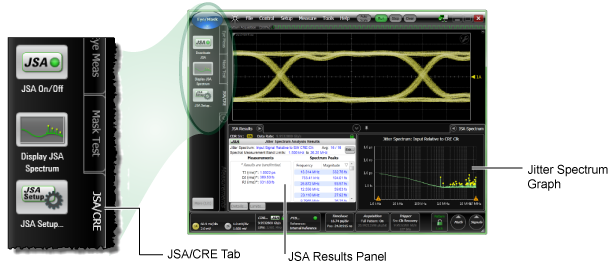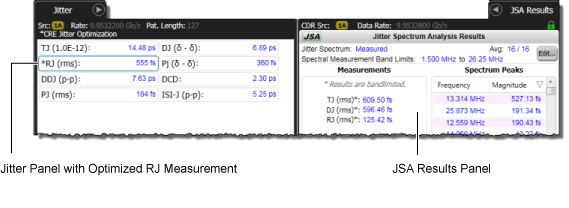JSA and CRE Toolbar
 Jitter Spectrum Analysis (JSA) and SW Clock Recovery Emulation (CRE), provides greater insights concerning jitter and improves measurement accuracy. In Jitter Mode, clock recovery emulation can be performed and a jitter spectrum graph is displayed that shows the spectral distribution of low-frequency jitter.
Jitter Spectrum Analysis (JSA) and SW Clock Recovery Emulation (CRE), provides greater insights concerning jitter and improves measurement accuracy. In Jitter Mode, clock recovery emulation can be performed and a jitter spectrum graph is displayed that shows the spectral distribution of low-frequency jitter.
The JSA toolbar is available in Oscilloscope, Eye/Mask, and Jitter modes.
Requires an N1060A, N1076A, N1076B, N1077A, N1077B, N1078A or 86108A/B clock-recovery module that has Option JSA.
License Packages N1010100A RND and N1010300A SI enable the JSA option for the N1076B, N1077A, N1077B, N1078A and N1092A/B CDR clock-recovery module which requires FlexDCA firmware version A.07.40 or later.
JSA's Benefits
- Emulation of most clock recovery designs (1st or 2nd order, adjustable bandwidth and peaking) without hardware limitations.
- Improved compliance by better emulation of existing and future standards-based CR requirements.
- Better accuracy by removing non-ideal behavior of hardware clock recovery. For example, removing unwanted peaking that may artificially increase jitter results.
- Improved correlation to measurements performed by real-time scopes that employ software clock recovery.
JSA/CRE Toolbar
Using Clock Recovery Emulation (CRE), you can configure JSA to observe the low-frequency jitter on the Input, Measured, or Emulated signal. In Jitter mode, you can also simultaneously and independently apply clock recovery emulation to optimize Jitter Mode's RJ measurement which is listed in the Jitter panel. For example, you can view the JSA results and spectrum for the Measured signal while applying CRE to optimize the standard Jitter-mode RJ measurement.


Jitter Mode requires the Research and Developement package license.
Before JSA measurements can be made, clock recovery must be locked.
Turning on the JSA Spectrum graph slows the display's update rate.



